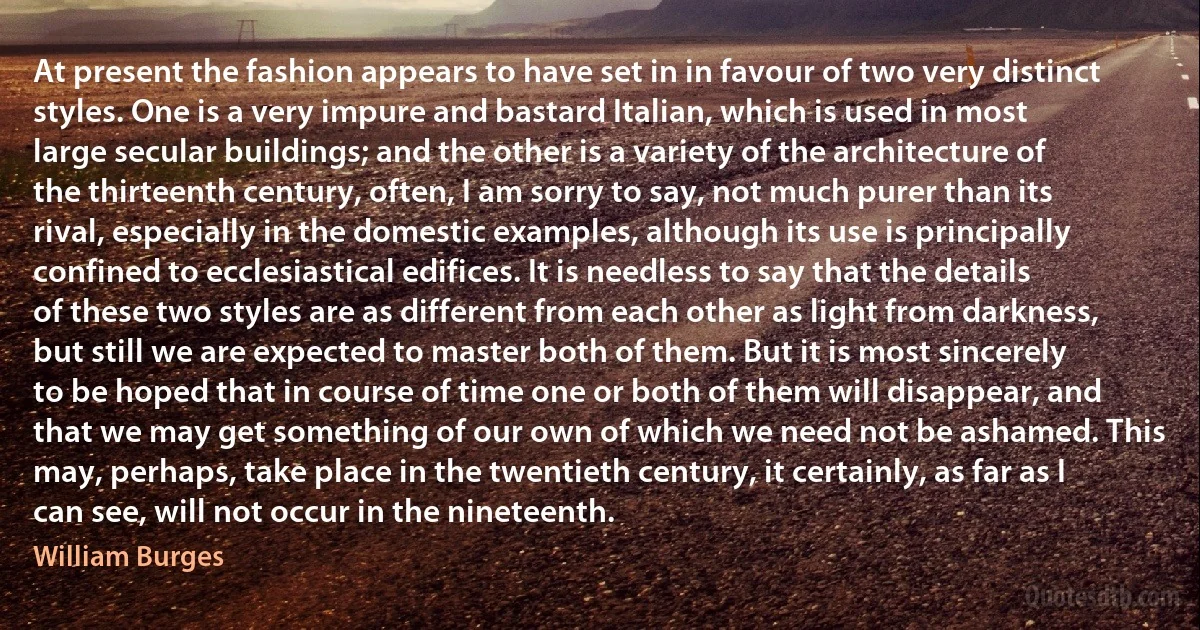
At present the fashion appears to have set in in favour of two very distinct styles. One is a very impure and bastard Italian, which is used in most large secular buildings; and the other is a variety of the architecture of the thirteenth century, often, I am sorry to say, not much purer than its rival, especially in the domestic examples, although its use is principally confined to ecclesiastical edifices. It is needless to say that the details of these two styles are as different from each other as light from darkness, but still we are expected to master both of them. But it is most sincerely to be hoped that in course of time one or both of them will disappear, and that we may get something of our own of which we need not be ashamed. This may, perhaps, take place in the twentieth century, it certainly, as far as I can see, will not occur in the nineteenth.
William BurgesRelated topics
architecture century course darkness different far fashion large light master need nineteenth perhaps place present say secular see set something sorry take time use favourRelated quotes
We may also observe, that, upon these occasions, the female Nimrods dispensed with the method of riding best suited to the modesty of the sex, and sat astride on the saddle like the men; but this indecorous custom, I trust, was never general, nor of long continuance, even with the heroines who were most delighted with these masculine exercises. An author of the seventeenth century speaks of another fashion, adopted by the fair huntresses of the town of Bury in Suffolk. "The Bury ladies," says he, "that used hawking and hunting, were once in a great vaine of wearing breeches," which it seems gave rise to many severe and ludicrous sarcasms. The only argument in favour of this habit, was decency in case of an accident. But in a manner more consistent with the delicacy of the sex, that is, by refraining from those dangerous recreations.

Joseph Strutt
Algebraic geometry has developed in waves, each with its own language and point of view. The late nineteenth century saw the function-theoretic approach of Riemann, the more geometric approach of Brill and Noether, and the purely algebraic approach of Kronecker, Dedekind, and Weber. The Italian school followed with Castelnuovo, Enriques, and Severi, culminating in the classification of algebraic surfaces. Then came the twentieth-century "American" school of Chow, Weil, and Zariski, which gave firm algebraic foundations to the Italian intuition. Most recently, Serre and Grothendieck initiated the French school, which has rewritten the foundations of algebraic geometry in terms of schemes and cohomology, and which has an impressive record of solving old problems with new techniques. Each of these schools has introduced new concepts and methods.

Robin Hartshorne
True Religion does not manifest itself outwardly, and impels man to no course of external conduct which he would not otherwise have adopted, but that it only completes his true In ward Being and Dignity. It is neither an Action, nor an incentive to Action, but a Thought:-it is LIGHT, and the One True Light, which bears within it all Life and all the forms of Life, and pervades their innermost substance. Once arisen, this Light flows on spontaneously forever, spreading itself forth without term or limit;-and it is as idle to bid it shine, as it would be to address such a command to the material sun when it stands in the noon-day heavens. It does this without our bidding; and if it shine not, then has it not arisen. At its uprising, Darkness, and the brood of spectres and phantasms which are born of Darkness, vanish of themselves.

Johann Gottlieb Fichte
In fact, the only person to rival Friedman for policy influence in the twentieth century is John Maynard Keynes, who had a strikingly different view of the role of government. Keynes was influential because he advocated more government intervention into what he perceived as poorly functioning private economies caught up in the Great Depression. In contrast to Keynes, Friedman put the main blame for the Depression on government failures, especially of monetary policy. Hence, the Depression did not make Friedman a fan of big government. He also found in the Federal Reserve's failure to prevent deflation an argument in favor of monetary rules. As the world evolved- with low inflation becoming the major mission of central banks and free markets and secure property rights becoming the main policies to promote economic growth-Friedman surely won the intellectual battle.

Robert Barro
I envisaged future generations of Iranians proudly taking their rightful place among the vast family of nations, and fulfilling their responsibilities with dignity. I hoped to see dispelled for ever the medieval shadows from which Iran had emerged only half a century ago, and that the light which is the very essence of Iranian civilization and culture would prevail. Throughout my reign, I lived only for the realization of this dream which was beginning to become reality.
It will be seen that I worked tirelessly and keenly to this end. I had ceaselessly to struggle against all sorts of obstacles and difficulties. I had to confront innumerable plots and intrigues both inside the country and abroad. I combated the all-powerful, multi-national trusts and cartels when all my advisers warned me against such challenges. I may have made mistakes, of course, but this long battle was not one of them.

Muhammad Reza Pahlavi
